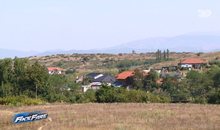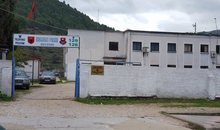
 Flash News
Flash News
Dozens of administrative units without children, how is the South dying out?

In the administrative unit of Frashër in Përmet, when the 2023 census was conducted, there were fewer than two children per 100 inhabitants. In Voskopoja, there were also only 2 children per 100 inhabitants.
Detailed data from the 2023 Census indicate that rural areas, mainly in the South of the country, will disappear in the not-so-distant future due to a lack of children.
In the administrative units of Frashër, Voskopoje, Pogon, Aliko, Zagori, Mesopotan, Ngraçan, Dhiver, Qendër Leskovik, Odrie, Finiq, Livadhja, Çepan, Dropull i posiđem, children under 14 years of age were less than 5% of the total population.
In 14 administrative units (out of 377 administrative units, which also includes municipalities) the number of children aged 0-14 accounted for less than 5 percent of the total population (see graph below.
In 32 other administrative units, it is seen that children aged 0-14 account for 5-10 percent of the total population.
In 177 administrative units, children accounted for 10-15% of the total population.
In 33 units, children aged 0-14 accounted for 15 to 20% of the total population, and in only 24 administrative units did children account for over 20-27 percent of the total population.
The former municipality of Tërthore in Kukës ranks as the administrative unit with the highest number of children in relation to the total population. Census 2023 data showed that in this administrative unit 27 percent of the residents were under 14 years old.
The second ranked administrative unit is Gjinaj, also in Kukës, in which 26.1% of the residents were children, followed by the former Kolsh Municipality, also in Kukës, where 25% of the residents were children.
The Administrative Units of Kukës lead for the still high ratios of children in relation to the population compared to other regions of the country. The administrative units, Zapod, Surroj, Fajzë, Shtiqen, Arrën, Grykë Qajë, Ujmisht, Golaj, Krumë, Bicaj, Kalis are all part of the Kukës municipality and have the highest number of children in relation to the population with over 21%, ranking at the top of the administrative units for the young population. These units also have significantly decreased birth rates during the transition, but still the birth rates are the highest in the country. On the other hand, these units also have the highest level of poverty in the country.
The 2023 Census data on demographic composition informs how public funds should be allocated, especially in education. Meanwhile, in the southern administrative units, infrastructure for the elderly needs to be prepared more quickly.
As the vast majority of the country's population ages, neither local nor central government is adapting social policies to demographic developments. In the North, school dropout is increasing due to school closures and concentration, while in the South, thousands of elderly people suffering from chronic diseases are not receiving social care.
In the 2011 census, the 0-14 age group accounted for 20.6 percent of the total population, while in the previous year's census it was 15.5%.
In 2011, there were 578.5 thousand young people under 14 years old, while in 2023 only 373.9 thousand, a decrease of 35%.
The youth dependency ratio decreased to 24.0 percent from 30.4 percent estimated in the 2011 Census, and the elderly dependency ratio increased to 30.4 percent from 16.7 percent in 2011.
Analyzed at the regional level, Kukës and Gjirokastra hold opposite positions in terms of dependency ratios: Kukës has the highest youth dependency ratio of 31.8 percent and the lowest elderly dependency ratio of 19.9 percent.
Meanwhile, Gjirokastra has the lowest youth dependency ratio (19.0 percent) and the highest elderly dependency ratio (46.1 percent). The average age of the population is 42.5 years, up from 35.3 years in the 2011 Census./ Monitor
Latest news


Two vehicles collide on the Elbasan-Peqin axis, drivers injured
2025-07-05 19:26:29

What does Zelenskyy have more than Zegjineja?
2025-07-05 18:45:26

Fiscal peace, but at a cost
2025-07-05 18:00:10
'Bankers' tax evasion, Chinese CEO and former director jailed
2025-07-05 17:39:21
Kyle Walker joins English club on two-year deal
2025-07-05 17:20:24
Two cars collide on the Saranda-Delvina axis, 4 injured
2025-07-05 17:05:29
Touching gesture! Liverpool will pay Jota's family's salary until 2027
2025-07-05 16:45:18
The zodiac signs that cheat most often
2025-07-05 16:25:53

"I asked for the dismissals", Dredha tries to soften Rama's 'blow' in Vlora
2025-07-05 15:48:49
Bomb threat in Parliament, prosecutor: It was a lie
2025-07-05 15:22:28

Bardhi: The recount revealed how greedy Zeqine Balluku is in stealing
2025-07-05 14:44:29
Knife wound on the secondary road Tirana-Durrës, perpetrator sought
2025-07-05 14:37:54
Tears and pain, Diogo Jota is escorted to his final home
2025-07-05 14:21:34
Success starts with yourself! Simple ways to invest in personal development
2025-07-05 13:58:50
Unlicensed firearms found in apartment, 50-year-old arrested in Lushnje
2025-07-05 13:43:11

Tirana Court remands Skerdi Sina to prison
2025-07-05 12:59:34
Cocaine laboratory in Greece, here are the Albanians arrested and wanted
2025-07-05 12:40:16
Directed Justice/Vangjeli: SPAK does not investigate any scandal involving Rama
2025-07-05 12:22:03

Bomb alert, Police remove MPs and media from Kosovo Parliament building
2025-07-05 11:48:16
"The will of the people" and the irony of ordered resignations
2025-07-05 11:32:05
Summer drowning risk: How to enjoy the water without risking your life
2025-07-05 11:20:27
Fire situation in the country, 16 fires reported in 24 hours, 4 still active
2025-07-05 11:07:04
Car hits pedestrian at white lines, injured in serious condition in Vlora
2025-07-05 10:59:58
Mosquito-borne diseases are a growing problem in Europe
2025-07-05 10:44:13



One of Sweden's most dangerous and wanted criminals arrested in Turkey
2025-07-05 09:38:29
Foreign exchange/ How much foreign currencies are bought and sold today
2025-07-05 09:18:38

"Don't be influenced by the opinions of others", today's horoscope
2025-07-05 08:40:50

Morning Post/ In 2 lines: What mattered yesterday in Albania
2025-07-05 08:02:07

Trump says he's ready to raise tariffs to 70% on some countries
2025-07-04 22:35:52
Tre shenjat e zodiakut që do ‘pasurohen’ në Korrik
2025-07-04 22:05:09
Gaza War: Hamas Accepts US Proposal for 60-Day Ceasefire
2025-07-04 21:50:10
Autocracy in Albania, Fuga: Governance has gotten out of control
2025-07-04 21:40:51
Meta: Agriculture on credit, the new fraud!
2025-07-04 21:26:39




Vote recount in Durrës ends without changes
2025-07-04 20:12:54
Gas station explodes in Rome, 25 injured (VIDEO)
2025-07-04 20:00:20

These afternoon habits often sabotage weight loss
2025-07-04 19:39:28
Former Arsenal player Thomas Partey accused of rape
2025-07-04 19:24:21
Shepherd disappears without a trace in Delvina
2025-07-04 19:14:31

Bardho gave Zegjine's mandate/Braho: Unfair! It violates the electoral system
2025-07-04 19:01:08


Rapid developments in the Sultanates!
2025-07-04 18:00:06



Italy tightens rules for skateboard traffic
2025-07-04 17:20:18

Unusual for the time, dense fog covers the coast of Vlora
2025-07-04 16:48:01


Accident on the Shkodra-Lezhë axis, one dead and 3 injured
2025-07-04 16:14:19
Albania with fewer requests for asylum and Albanian citizenship in 2024
2025-07-04 16:06:57

Albania last for quality of life, DP: Technical government is the solution!
2025-07-04 15:42:30
Nico Williams says "No" to Barcelona, signs with Athletic Club until 2035
2025-07-04 15:33:35
Fires in the country, four fires are still active, what is the situation?
2025-07-04 15:24:20

Summer brings big changes for these 4 zodiac signs
2025-07-04 15:00:04
Osmani: MPs need to agree to a secret ballot for the Speaker of Parliament
2025-07-04 14:51:09
Serious accident on the Peqin-Elbasan axis, two injured
2025-07-04 14:37:56

GJKKO leaves in force the security measure for the head of the KPP
2025-07-04 13:58:17
Who will replace Ilir Meta and take over the leadership of the PL?
2025-07-04 13:50:36
Berisha: Dismissal of directors in Vlora, another act of 'scapegoats'
2025-07-04 13:41:46




Librazhd/ In a serious psychological state, the young man consumes pesticides
2025-07-04 13:05:07


Weapons trafficked from Kosovo to Albania, two arrested, 8 pistols seized
2025-07-04 12:33:28
Konsumimi i tepërt i çokollatës, ja cilat janë dëmet që shkakton në organizëm
2025-07-04 12:23:35

Fires in the country, 21 fires in the last 24 hours, 4 still active
2025-07-04 12:00:19
WB calls for debt transparency: Albania to publish details of every loan
2025-07-04 11:50:05
Changes in the State Police, new names expected to lead 5 police stations
2025-07-04 11:40:06

The race for the head of the BKH, the third phase on July 11
2025-07-04 11:20:23

